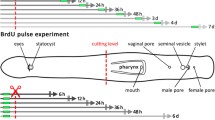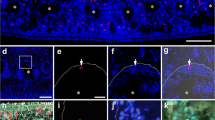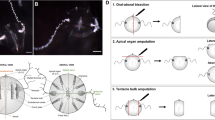Abstract
Neoblasts are potentially totipotent stem cells and the only proliferating cells in adult Platyhelminthes. We have examined the cellular dynamics of neoblasts during the posterior regeneration of Macrostomum lignano. Double-labeling of neoblasts with bromodeoxyuridine and the anti-phospho histone H3 mitosis marker has revealed a complex cellular response in the first 48 h after amputation; this response is different from that known to occur during regeneration in triclad platyhelminths and in starvation/feeding experiments in M. lignano. Mitotic activity is reduced during the first 8 h of regeneration but, at 48 h after amputation, reaches almost twice the value of control animals. The total number of S-phase cells significantly increases after 1 day of regeneration. A subpopulation of fast-cycling neoblasts surprisingly shows the same dynamics during regeneration as those in control animals. Wound healing and regeneration are accompanied by the formation of a distinct blastema. These results present new insights, at the cellular level, into the early regeneration of rhabditophoran Platyhelminthes.





Similar content being viewed by others
References
Agata K (2003) Regeneration and gene regulation in planarians. Curr Opin Genet Dev 13:492–496
Agata K, Watanabe K (1999) Molecular and cellular aspects of planarian regeneration. Semin Cell Dev Biol 10:377–383
Baguñà J (1974) Dramatic mitotic response in planarians after feeding, and a hypothesis for the control mechanism. J Exp Zool 190:117–122
Baguñà J (1976) Mitosis in the intact and regenerating planarian Dugesia mediterranea n. sp. II. Mitotic studies during regeneration, and a possible mechanism of blastema formation. J Exp Biol 195:65–80
Baguñà J (1981) Planarian neoblasts. Nature 290:14–15
Baguñà J (1998) Planarians. In: Ferretti P, Geraudie J (eds) Cellular and molecular basis of regeneration: from invertebrates to human. Wiley, Chichester, pp 135–166
Baguñà J, Riutort M (2004a) Molecular phylogeny of the Platyhelminthes. Can J Zool 82:168–193
Baguñà J, Riutort M (2004b) The dawn of bilaterian animals: the case of acoelomorph flatworms. BioEssays 26:1046–1057
Baguñà J, Romero R (1981) Quantitative analysis of cell types during growth, degrowth and regeneration in the planarians Dugesia mediterranea and Dugesia tigrina. Hydrobiologia 84:181–194
Baguñà J, Saló E, Auladell C (1989) Regeneration and pattern formation in planarians. III. Evidence that neoblasts are totipotent stem cells and the source of blastema cells. Development 107:77–86
Baguñà J, Romero R, Saló E, Collet J, Auladell C, Ribas M, Riutort M, Garcia-Fernandez J, Burgaya F, Bueno D (1990) Growth, degrowth and regeneration as developmental phenomena in adult freshwater planarians. In: Marthy HJ (ed) Experimental embryology in aquatic plants and animals. Plenum, New York, pp 129–162
Baguñà J, Saló E, Romero R, Garcia-Fernandez J, Bueno D, Muñoz-Marmol AM, Bayascas-Ramirez JR, Casali A (1994) Regeneration and pattern formation in planarians: cells, molecules and genes. Zool Sci 11:781–795
Best JB, Hand S, Rosenvold R (1968) Mitosis in normal and regenerating planarians. J Exp Biol 168:157–168
Bode A, Salvenmoser W, Nimeth K, Mahlknecht M, Adamski Z, Rieger RM, Ladurner P (2006) The neoblast stem cells of Macrostomum sp. (Platyhelminthes): ultrastructure of immunogold labeled S-phase cells and non S-phase neoblasts, their numbers and distribution. Cell Tissue Res (in press)
Brøndsted H (1969) Planarian regeneration. Pergamon, Oxford London
Carranza S, Baguñà J, Riutort M (1997) Are the Platyhelminthes a monophyletic primitive group? An assessment using 18S rDNA sequences. Mol Biol Evol 14:485–497
Cook CE, Jimenez E, Akam M, Saló E (2004) The Hox gene complement of acoel flatworms, a basal bilaterian clade. Evol Dev 6:154–163
Drobysheva IM (1986) Physiological regeneration of the digestive parenchyma in Convoluta pulchra and Oxyposthia praedator (Turbellaria, Acoela). Cytometry 132:189–193
Dubois F (1949) Contribution à l’étude de la migration des cellules de régénération chez les planaires dulcicoles. Bull Biol Fr Belg 83:213–283
Egger B, Ladurner P, Nimeth K, Gschwentner R, Rieger R (2006a) The regeneration capacity of the flatworm Macrostomum lignano - on repeated regeneration, rejuvenation, and the minimal size needed for regeneration. Dev Genes Evol, DOI 10.1007/s00427-006-0069-4
Egger B, Ladurner P, Nimeth K, Gschwentner R, Rieger R (2006b) The regeneration capacity of the flatworm Macrostomum lignano - on repeated regeneration, rejuvenation, and the minimal size needed for regeneration. Dev Genes Evol, DOI 10.1007/s00427-006-0079-2 (erratum)
Ehlers U (1985) Das Phylogenetische System der Plathelminthes. Fischer, Stuttgart
Gabriel A (1970) Etude morphologique et évolution biochimique des néoblastes au cours des premières phases de la régénération des planaires d´eau douce. Annls Embryol Morphogen 3:49–69
Gremigni V, Miceli C (1980) Cytophotometric evidence for cell “transdifferentiation” in planarian regeneration. Arch Entwm 188:107–113
Gschwentner R, Ladurner P, Nimeth K, Rieger R (2001) Stem cells in a basal bilaterian. S-phase and mitotic cells in Convolutriloba longifissura (Acoela, Platyhelminthes). Cell Tissue Res 304:401–408
Heidenhain M (1885)Eine neue Verwendung des Hämatoxylin. Archiv Mikrosk Anat 24:468–470
Hori I (1997) Cytological approach to morphogenesis in the planarian blastema. II. The effect of neuropeptides. J Submicrosc Cytol Pathol 29:91–97
Hori I, Kishida Y (1998) A fine-structural study of regeneration after fission in the planarian Dugesia japonica. Hydrobiologia 383:131–136
Hori I, Hikosaka-Katayama T, Kishida Y (1999) Cytological approach to morphogenesis in the planarian blastema. III. Ultrastructure and regeneration of the acoel turbellarian Convoluta naikaiensis. J Submicrosc Cytol Pathol 31:247–258
Ito H, Saito Y, Watanabe K, Orii H (2001) Epimorphic regeneration of the distal part of the planarian pharynx. Dev Genes Evol 211:2–9
Ladurner P, Rieger R (2000) Embryonic muscle development of Convoluta pulchra (Turbellaria-Acoelomorpha, Platyhelminthes). Dev Biol 222:359–375
Ladurner P, Rieger R, Baguñà J (2000) Spatial distribution and differentiation potential of stem cells in hatchlings and adults in the marine platyhelminth Macrostomum sp.: a bromodeoxyuridine analysis. Dev Biol 226:231–241
Lindh NO (1957) The mitotic activity during the early regeneration in Euplanaria polychroa. Arkiv Zool 10:497–509
Mollenhauer HH (1964) Plastic embedding mixtures for use in electron microscopy. Stain Technol 39:111–114
Montgomery JR, Coward SJ (1974) On the minimal size of a planarian capable of regeneration. Trans Am Microsc Soc 93:386–391
Moore J, Willmer P (1997) Convergent evolution in invertebrates. Biol Rev Cambridge Philos Soc 72:1–60
Newmark PA, Sánchez Alvarado A (2000) Bromodeoxyuridine specifically labels the regenerative stem cells of planarians. Dev Biol 220:142–153
Newmark PA, Sánchez Alvarado A (2002) Not your father’s planarian: a classic model enters the era of functional genomics. Nat Rev Genet 3:210–219
Nimeth K, Ladurner P, Gschwentner R, Salvenmoser W, Rieger R (2002) Cell renewal and apoptosis in Macrostomum sp. (Lignano). Cell Biol Int 26:801–815
Nimeth KT, Mahlknecht M, Mezzanato A, Peter R, Rieger R, Ladurner P (2004) Stem cell dynamics during growth, feeding and starvation in the basal flatworm Macrostomum sp. (Platyhelminthes). Dev Dyn 230:91–99
Palmberg I (1986) Cell migration and differentiation during wound healing and regeneration in Microstomum lineare (Turbellaria). Hydrobiologia 132:181–188
Palmberg I (1990) Stem cells in microturbellarians: an autoradiographic and immunocytochemical study. Protoplasma 158:109–120
Pasquinelli AE, McCoy A, Jimenez E, Saló E, Ruvkun G, Martindale MQ, Baguñà J (2003) Expression of the 22 nucleotide let-7 heterochronic RNA throughout the Metazoa: a role in life history evolution? Evol Dev 5:372–378
Peter R (2001) Experimentelle Systeme zum Studium von Regenerationsvorgängen: Turbellarien als Modellorganismen mit einem Stammzellensystem. Ber Nat-Med Verein Innsbruck 88:287–350
Peter R, Ladurner P, Rieger RM (2001) The role of stem cell strategies in coping with environmental stress and choosing between alternative reproductive modes: Turbellaria rely on a single cell type to maintain individual life and propagate species. Mar Ecol PSZNI 22:35–51
Peter R, Gschwentner R, Schürmann W, Rieger RM, Ladurner P (2004) The significance of stem cells in free-living flatworms: one common source for all cells in the adult. J Appl Biomed 2:21–35
Reddien PW, Oviedo NJ, Jennings JR, Jenkin JC, Sánchez Alvarado A (2005) SMEDWI-2 is a PIWI-like protein that regulates planarian stem cells. Science 310:1327–1330
Reuter M, Kreshchenko N (2004) Flatworm asexual multiplication implicates stem cells and regeneration. Can J Zool 82:334–356
Rieger R (1996) Plathelminthes, Plattwürmer. In: Westheide W, Rieger R (eds) Spezielle Zoologie. I. Einzeller und Wirbellose Tiere. Fischer, Stuttgart, pp 210–258
Rieger RM, Gehlen M, Haszprunar G, Holmlund M, Legniti A, Salvenmoser W, Tyler S (1988) Laboratory cultures of marine Macrostomida (Turbellaria). Forts Zool 36:525
Rieger RM, Salvenmoser W, Legniti A, Tyler S (1994) Phalloidin-rhodamine preparations of Macrostomum hystricinum marinum (Plathelminthes): morphology and postembryonic development of the musculature. Zoomorphology 114:133–147
Rieger RM, Legniti A, Ladurner P, Reiter D, Asch E, Salvenmoser W, Schürmann W, Peter R (1999) Ultrastructure of neoblasts in microturbellaria: significance for understanding stem cells in free-living Platyhelminthes. Invertebr Repr Dev 35:127–140
Saló E, Baguñà J (1984) Regeneration and pattern formation in planarians. I. The pattern of mitosis in anterior and posterior regeneration in Dugesia (G) tigrina, and a new proposal for blastema formation. J Embryol Exp Morphol 83:63–80
Saló E, Baguñà J (2002) Regeneration in planarians and other worms: new findings, new tools, and new perspectives. J Exp Zool 292:528–539
Salvenmoser W, Riedl D, Ladurner P, Rieger R (2001) Early steps in the regeneration of the musculature in Macrostomum sp. (Macrostomorpha, Platyhelminthes). Belg J Zool 131 (Suppl 1):105–109
Salvetti A, Batistoni R, Deri P, Rossi L, Sommerville J (1998) Expression of DjY1, a protein containing a cold shock domain and RG repeat motifs, is targeted to sites of regeneration in planarians. Dev Biol 201:217–229
Salvetti A, Rossi L, Deri P, Batistoni R (2000) An MCM2-related gene is expressed in proliferating cells of intact and regenerating planarians. Dev Dyn 218:603–614
Sánchez Alvarado A, Newmark PA, Robb SMC, Juste R (2002) The Schmidtea mediterranea database as a molecular resource for studying platyhelminthes, stem cells and regeneration. Development 129:5659–5665
Telford MJ, Lockyer AE, Cartwright-Finch C, Littlewood DT (2003) Combined large and small subunit ribosomal RNA phylogenies support a basal position of the acoelomorph flatworms. Proc R Soc Lond [Biol] 270:1077–1083
Tyler S (1976) Comparative ultrastructure of adhesive systems in the Turbellaria. Zoomorphologie 84:1–76
Tyler S (2001) The early worm: origins and relationship of the lower flatworms. In: Littlewood DTJ, Bray RA (eds) Interrelationships of the Platyhelminthes. Taylor & Francis, New York, pp 3–12
Acknowledgements
We are grateful to Gunde Rieger for critical comments on earlier drafts of the manuscript and to Peter Ladurner for stimulating discussions. We thank Professor B. Pelster, Institute of Zoology and Limnology, Innsbruck, for allowing us to use his confocal microscope.
Author information
Authors and Affiliations
Corresponding author
Additional information
This work was supported by FWF Grant (P16618; P.I. Rieger, Innsbruck).
Rights and permissions
About this article
Cite this article
Nimeth, K.T., Egger, B., Rieger, R. et al. Regeneration in Macrostomum lignano (Platyhelminthes): cellular dynamics in the neoblast stem cell system. Cell Tissue Res 327, 637–646 (2007). https://doi.org/10.1007/s00441-006-0299-9
Received:
Accepted:
Published:
Issue Date:
DOI: https://doi.org/10.1007/s00441-006-0299-9




